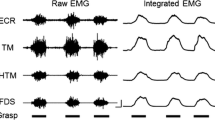Summary
The mechanical activity of the isolatedflexor carpi radialis muscle (FCRM) of the mature male frog (Rana temporaria) was compared to that of thesartorius muscle. Muscles were stimulated directly by massive shocks at 20°C and isometric tension was recorded during single twitch, twitch series, long tetani and long tetanus series. Some groups of muscles were poisoned with IAA-N2 or FDNB. The FCRM showed a high resistance to fatigue during a tetanus series and a “fatigue contracture” during a twitch series. The rate of the tetanic tension rise was smaller by five to six times than in thesartorius muscle (0 to 50% P0) and the twitch/tetanus ratio was always very small. During continuous activity and after the blocking of recovery metabolic pathways, FCRM used its energetic stores two to three times slower than thesartorius muscle. These stores did not seem to be more important.
The results indicate that the FCRM is not a “tonic” muscle but, quite possibly, is composed of several types of fibre like many other frog muscles. However, some characteristics of mechanical response cannot be explained by the common classification into two types of fibre.
Similar content being viewed by others
References
Baguet, F., Gillis, J. M.: Energy cost of tonic contraction in a Lamellibranch catch muscle. J. Physiol. (Lond.)198, 127–143 (1968)
Cain, D. F., Davies, R. E.: Breakdown of adenosine triphosphate during a single contraction of working muscle. Biochem. biophys. Res. Commun.8, 361–366 (1962)
Canfield, P., Marechal, G.: Equilibrium of nucleotides in frog sartorius during an isometric tetanus at 20°C. J. Physiol. (Lond.)232, 453–466 (1973)
Close, R.: Dynamic properties of Mammalian skeletal muscles. Physiol. Rev.52, 129–197 (1972)
Constantin, L. L., Podolsky, R. J., Tice, L. W.: Calcium activation of frog slow muscle fibers. J. Physiol. (Lond.)188, 261–271 (1967)
Eberstein, A., Sandow, A.: Fatigue in phasic and tonic fibers of frog muscle. Science134, 383–384 (1961)
Eberstein, A., Sandow, A.: Fatigue mechanisms in muscle fibers. In: The effect of use and disuse on neuromuscular functions, pp. 515–526. Ed. E. Gutmann. Praha: Publ. House Czech. Acad. Sci., 1963
Ecker, A., Wiederscheim, R., Gaupp, E.: Anatomie des Frosches. Auf Grund eigener Untersuchungen durchaus neu bearbeitet. Vol. I. Braunschweig: Vieweg und Sohn, 1896
Flitney, F. W.: The volume of the T-system and its association with the sacroplasmic reticulum in slow muscle fibres of the frog. J. Physiol. (Lond.)217, 243–257 (1971)
Floyd, K., Smith, I. C. H.: The mechanical and thermal properties of frog slow muscle fibres. J. Physiol. (Lond.)213, 617–631 (1971)
Franzini-Armstrong, C.: Studies of the triad. IV. Structure of the junction in frog slow fibres. J. Cell Biol.56, 120–128 (1973)
Grabowski, W., Lobsiger, E. A., Lüttgau, H. CH.: The effect of repetitive stimulation at low frequencies upon the electrical activity of single muscle fibres. Pflügers Arch.334, 222–239 (1972)
Irwin, R. L., Oliver, K. L.: Prevention of relaxation in slow skeletal muscle by inhibition of active transport of sodium. Amer. J. Physiol.218, 1261–1223 (1970)
Kirby, A. C.: Frog tonic muscle fibers: extra cellular calcium and excitation-contraction coupling. Amer. J. Physiol.219, 1446–1450 (1970)
Krüger, P., Duspiva, F., Fürlinger, F.: Tetanus und Tonus der Skeletmuskeln des Frosches, eine histologische, reizphysiologische und chemische Untersuchung. Pflügers Arch. ges. Physiol.231, 750–786 (1933)
Kuffler, S. W., Vaughan Williams, E. M.: Properties of the slow skeletal muscle fibres of the frog. J. Physiol. (Lond.)121, 318–340 (1953)
Lännergren, J., Smith, R. S.: Types of muscle fibres in toad skeletal muscle. Acta physiol. scand.68, 263–274 (1966)
László, M., Tigyi, J.: Myosinkristallisation beim Umklammerungsreflex. Acta physiol. Acad. Sci. hung.16, 117–122 (1959)
Lundsgaard, E.: Weitere Untersuchungen über Muskelkontraktionen ohne Milchsäurebildung. Biochem. Z.227, 51–83 (1930)
Marechal, G.: Développement de la contracture iodacétique du muscle strié par tétanisation prolongée. Arch. int. Physiol. Biochim.66, 182–197 (1958)
Marechal, G., Aubert, X.: Composantes multiples de la fatigue du muscle isolé révélées pas l'analyse mécanique et thermique de la contraction. J. Physiol. (Paris)50, 404–406 (1958)
Marechal, G., Beckers-Bleukx, G.: Adenosine triphosphate and phosphorylcreatine breakdown in resting and stimulated muscles after treatment with 1-fluoro-2,4-dinitrobenzene. Biochem. Z.345, 286–299 (1966)
Melichna, J., Gutmann, E., Herbychova, A., Stichova, J.: Sexual dimorphism in contraction properties and fibre pattern of theflexor carpi radialis muscle of the frog (Rana temporaria). Experientia (Basel)28, 89–91 (1972)
Okong's, O., Becker, R., Alpert, N. R.: An electronic switch for massive stimulation of muscle. Experientia (Basel)26, 668–669 (1970)
Pauschinger, P., Brecht, K.: Der Einfluß von Änderungen der extracellulären Calciumkonzentration auf die Ermüdungskontraktur von Skeletmuskeln. Pflügers Arch. ges. Physiol.272, 254–261 (1961)
Ross, S. M., Brust, M.: A transistorized pulse amplifier for massive stimulation of muscle. J. appl. Physiol.20, 354 (1965)
Schaechtelin, G.: Der Einfluß von Calcium und Natrium auf die Kontraktur des M. Rectus abdominis. Pflügers Arch. ges. Physiol.273, 164–181 (1961)
Thibert, P., Nicolet, M.: Dimorphisme sexuel dans les muscles de la grenouille. Etude préliminaire sur le musclecoraco-radialis de Rana temporaria. Ann. scient. Univ. Besancon8, 37–45 (1972)
Wachholder, K.: Untersuchungen über tonische und nicht tonische Wirbeltiermuskeln. III. Mitteilung. Pflügers Arch. ges. Physiol.226, 274–291 (1930)
Wachholder, K., Ledebur, J. F. v.: Untersuchungen über tonische und nicht tonische Wirbeltiermuskeln. I. Mitteilung. Pflügers Arch. ges. Physiol.225, 627–642 (1930)
Wilkie, D. R.: Heat, work and phosphorylcreatice break-down in muscle. J. Physiol. (Lond.)195, 157–183 (1968)
Author information
Authors and Affiliations
Rights and permissions
About this article
Cite this article
Thibert, P., Nicolet, M. Tonic properties of theFlexor carpi radialis muscle of the male frog (Rana temporaria). Pflugers Arch. 356, 253–265 (1975). https://doi.org/10.1007/BF00583837
Received:
Issue Date:
DOI: https://doi.org/10.1007/BF00583837



